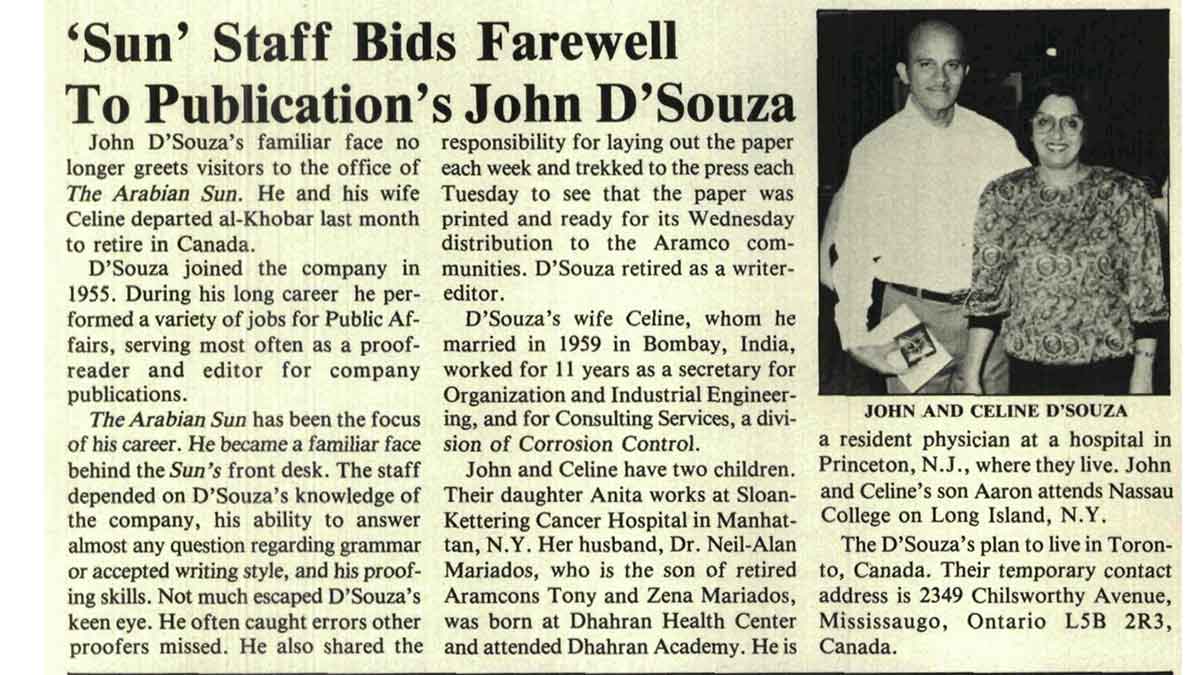This Day in History
This Day in History (1990): 'Sun' staff bids farewell to Publication's John D'Souza

Global August 01, 2023
Longtime writer-editor steps down after more than three decades in Aramco's Public Affairs.
From the Aug. 1, 1990, edition of The Arabian Sun
John D'Souza's familiar face no longer greets visitors to the office of "The Arabian Sun." He and his wife, Celine, departed al-Khobar last month to retire in Canada.
D'Souza joined the company in 1955. During his long career, he performed a variety of jobs for Public Affairs, serving most often as proof-reader and editor for company publications.
"The Arabian Sun" has been the focus of his career. He became a familiar face behind the "Sun's" front desk. The staff depended on D'Souza's knowledge of the company, his ability to answer almost any question regarding grammar or accepted writing style, and his proofing skills.
Not much escaped D'Souza's keen eye. He often caught errors other proofers missed. He also shared the responsibility for laying out the paper each week and trekked to the press each Tuesday to see that the paper was printed and ready for its Wednesday distribution to the Aramco communities.
D'Souza retired as a writer-editor.
D'Souza's wife, Celine, whom he married in Bombay, Indian, in 1959, worked for 11 years as a secretary for Organization and Industrial Engineering, and for Consulting Services, a division of Corrosion Control.
John and Celine have two children. Their daughter, Anita, works at Sloan-Kettering Cancer Hospital in Manhattan, N.Y. her husband, Dr. Neil-Alan Mariados, who is the son of retired Aramcons Tony and Zena Mariados, was born at Dhahran Health Center and attended Dhahran Academy. He is a resident physician at a hospital in Princeton, N.J., where they live.
John and Celine's son, Aaron, attends Nassau College on Long Island, N.Y.
The D'Souzas plan to live in Toronto, Canada.
Also on this date
2008 — Eleven mountaineers on international expeditions die on K2, the second-highest mountain on Earth, in the worst single accident in the history of K2 mountaineering
2007 — The I-35W Mississippi River bridge spanning the Mississippi River in Minneapolis, Minnesota, collapses during evening rush hour, killing 13 and injuring 145
2001 — Korey Stringer, an offensive lineman with the Minnesota Vikings, suffers heat stroke and dies at age 27 during the team's training camp in Mankato, Minnesota
1981 — MTV begins broadcasting in the United States and airs its first video, "video Killed the Radio Star," by the Buggles
1980 — Vigdis Finnbogadotitr is elected President of Iceland and becomes the world's first democratically elected female head of state
1971 — The concert for Bangladesh, organized by former Beatle George Harrison, is held at Madison Square Garden in New York city
1965 — Frank Herbert's novel "Dune" is published for the first time
1960 — Islamabad is declared the federal capital of the Government of Pakistan
1950 — Guam is organized as an unincorporated territory of the United States as President Harry S Truman signs the Guam Organic Act
1936 — The Olympics opens in Berlin with a ceremony presided over by Adolph Hitler
1914 — The German Empire declares war on the Russian Empire at the opening of World War I.
1907 — The first Scout camp begins on Brownsea Island, the origin of the worldwide Scouting movement
1893 — Henry Perky patents shredded wheat
1855 — The first ascent of Monte Rosa, the second-highest summit in the Alps, occurs
1834 — Slavery is abolished in the British Empire as the Slavery Abolition Act of 1833 comes into force, though it remains legal in the possessions of the East India Company until the passage of the Indian Slavery Act of 1843
1714 — George, Elector of Hanover, becomes King George I of Great Britain, marking the beginning of the Georgian era of British history
1571 — The Ottoman conquest of Cyprus is concluded with the surrender of Famagusta
30 BC — Octavian (later known as Augustus) enters Alexandria, Egypt, bringing it under the control of the Roman Republic



